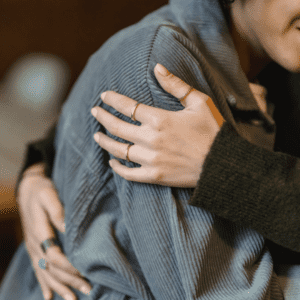 Content note: this post features a personal experience of intimate partner violence. If you need support, you can find a list of services that may be useful to you on our website.
Content note: this post features a personal experience of intimate partner violence. If you need support, you can find a list of services that may be useful to you on our website.
From the outside, it seemed like Laura had a great life.
She had a loving family, financial security, and she was going to university. But what people couldn’t see was that behind closed doors, she was living in an abusive relationship.
Her fears kept her trapped for three years as the emotional and sexual abuse continued. She began to distance herself from others, afraid of “what people would say” and the expectation that she would have to act or leave before she was ready.
“I was really concerned about being judged,” said Laura, a friend of the Canadian Women’s Foundation. “Would people wonder: ‘How could I let myself get into that situation?’”
Eventually, a situation with her then-partner escalated and the abusive relationship became known, prompting her to “face it.” It was then Laura took the brave step to ask for help.
“There were a few really key people in my life that were extremely supportive, [who] made me feel safe,” said Laura, specifically thanking her brother and sister-in-law. “They just intuitively knew that I would come to them when I wanted to talk about things, and they just let me take the lead in terms of getting myself through that situation.”
The key ingredients of a supportive response
The truth is, Laura is not alone in her experience. Nearly half of women in Canada (44%) have reported experiencing some form of psychological, physical or sexual violence. Perhaps even worse, gender-based violence is costing lives — every six days, a woman in Canada is killed by her intimate partner.
That’s why it’s so important that we listen and support people like Laura who choose to share their personal stories — so we know how to respond in a caring, patient, and non-judgmental way when it’s needed.
How can we respond in better, more helpful ways? Here’s what Laura shared based on her own personal experience:
- Understand that gender-based violence can happen to anyone. “There’s no one profile,” so “remove judgement” from your response if someone confides in you.
- Let them take the lead. While it’s human to want to “solve [the problem]” or “give advice,” remember the person being hurt is “the expert” on their own situation, including who they will reach out to or what are the right steps for them.
- Really listen — with your heart, eyes, ears, and body. That also means listening in silence , paying attention to emotions that can’t be expressed in words and allowing space for the person seeking support to listen and process internally.
“I’ve learned so much from people’s stories,” said Laura. “I hope any story I can share can help others as well.”
You can listen to Laura’s full story on our podcast, “Alright, Now What?”
Do you know how to respond to the Signal for Help, or any sign or signal of abuse? Go to signalresponder.ca to learn more and sign up as a Signal for Help Responder. When you do, you’ll receive the Signal for Help Responder’s Action Guide and join our learning journey, with more information on how to recognize abuse and offer stigma-free support.






